2019 MERCEDES-BENZ S CLASS park assist
[x] Cancel search: park assistPage 423 of 578

Wear safetyglasses.
Keepchildrenaway.
Observethis Operator's Manual.
Observethefollowing ifyou do not intendtousethevehicleover anextended period of time:
RActivatestandby mode.
RAlternatively: connectthe batterytoa bat‐terycharger approvedbyMercedes-Benz orconsult aqualified specialistworkshoptodisconnectthe battery.
Notes onstarting assistance and oncharg‐ingthe12V battery
Vehicles with a lithium-ion batteryWhenchargingthe battery and duringstartingassistance, alwaysusethe jump-startconnec‐tion point inthe engine compartment.
*NOTEDamagetothe battery fromover‐voltage
Whencharging using a batterycharger with‐out a maximumchargingvoltage,the batteryorthe on-board electronics may be damaged.
#Only use batterychargerswith a maxi‐mumchargingvoltage of14.4V.
AllothervehiclesWhenchargingthe battery and duringstartingassistance, alwaysusethe jump-startconnec‐tion point inthe engine compartment.
*NOTEDamagingthe batterythroughovervoltage
Whencharging using a batterycharger with‐out a maximumchargingvoltage,the batteryorthevehicle electronics may be damaged.
#Only use batterychargerswith a maxi‐mumchargingvoltage of14.8V.
&WARNINGRisk ofexplosion fromhydro‐gengas igniting
A batterygenerateshydrogengas duringthecharging process. Ifthere is a short circuit orsparksstarttoform,there is a danger ofthehydrogengas igniting.
#Make surethatthe positiveterminal ofthe connected battery does not comeinto contact withvehicle parts.
#Never place metal objects ortools on abattery.
#When connecting and disconnectingthebattery,you must observethe descri‐bed orderforthe battery clamps.
Breakdown assistance421
Page 424 of 578
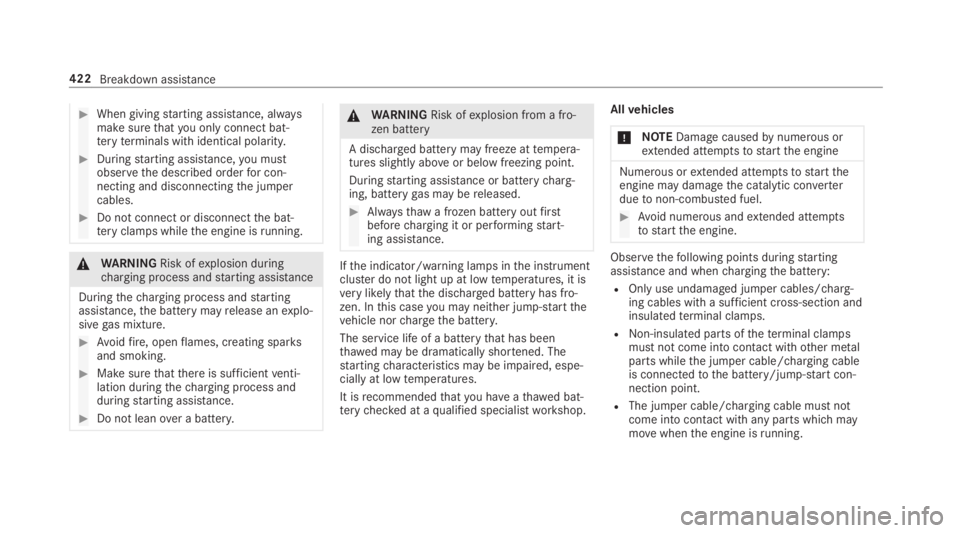
#When givingstarting assistance, alwaysmake surethatyou onlyconnect bat‐teryterminals with identical polarity.
#Duringstarting assistance,you mustobservethe described orderfor con‐necting and disconnectingthe jumpercables.
#Do not connect or disconnectthe bat‐teryclamps whilethe engine isrunning.
&WARNINGRisk ofexplosion duringcharging process andstarting assistance
Duringthecharging process andstartingassistance,the battery mayrelease anexplo‐sivegas mixture.
#Avoidfire, openflames, creating sparksand smoking.
#Make surethatthere is sufficientventi‐lation duringthecharging process andduringstarting assistance.
#Do not leanover a battery.
&WARNINGRisk ofexplosion from a fro‐zen battery
A discharged battery may freeze attempera‐tures slightly aboveor below freezing point.
Duringstarting assistance or batterycharg‐ing, batterygas may bereleased.
#Alwaysthawa frozen batteryoutfirstbeforecharging it or performingstart‐ing assistance.
Ifthe indicator/warning lamps inthe instrumentcluster do not light up at lowtemperatures, it isverylikelythatthe discharged battery has fro‐zen. Inthis caseyou may neither jump-startthevehicle norchargethe battery.
The service life of a batterythat has beenthawed may be dramatically shortened. Thestartingcharacteristics may be impaired, espe‐cially at lowtemperatures.
It isrecommendedthatyou haveathawed bat‐terychecked at aqualified specialistworkshop.
Allvehicles
*NOTEDamagecausedbynumerous orextended attemptstostartthe engine
Numerous orextended attemptstostarttheengine may damagethe catalytic converterduetonon-combusted fuel.
#Avoid numerous andextended attemptstostartthe engine.
Observethefollowing points duringstartingassistance and whenchargingthe battery:
ROnly use undamaged jumper cables/charg‐ing cables with a sufficient cross-section andinsulatedterminal clamps.
RNon-insulated parts oftheterminal clampsmust not come into contact withother metalparts whilethe jumper cable/charging cableis connectedtothe battery/jump-startcon‐nection point.
RThe jumper cable/charging cable must notcome into contact withany parts which maymovewhenthe engine isrunning.
422Breakdown assistance
Page 425 of 578
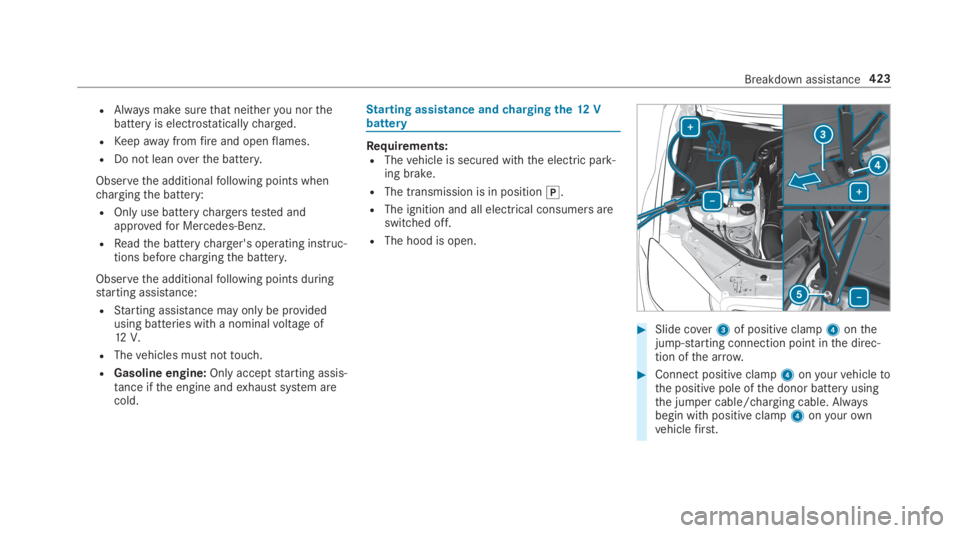
RAlways make surethat neitheryou northebattery is electrostaticallycharged.
RKeepawayfromfireand openflames.
RDo not leanoverthe battery.
Observethe additionalfollowing points whenchargingthe battery:
ROnly use batterychargerstested andapprovedfor Mercedes-Benz.
RReadthe batterycharger's operating instruc‐tions beforechargingthe battery.
Observethe additionalfollowing points duringstarting assistance:
RStarting assistance may only be providedusing batteries with a nominalvoltage of12V.
RThevehicles must nottouch.
RGasoline engine:Onlyacceptstarting assis‐tance ifthe engine andexhaust system arecold.
Starting assistance andchargingthe12 Vbattery
Requirements:RThevehicle is secured withthe electric park‐ing brake.
RThe transmission is in position�].
RThe ignition and all electrical consumers areswitched off.
RThe hood is open.
#Slide cover3of positive clamp4onthejump-starting connection point inthe direc‐tion ofthe arrow.
#Connect positive clamp4onyourvehicletothe positive pole ofthe donor battery usingthe jumper cable/charging cable. Alwaysbegin with positive clamp4onyourownvehiclefirst.
Breakdown assistance423
Page 428 of 578
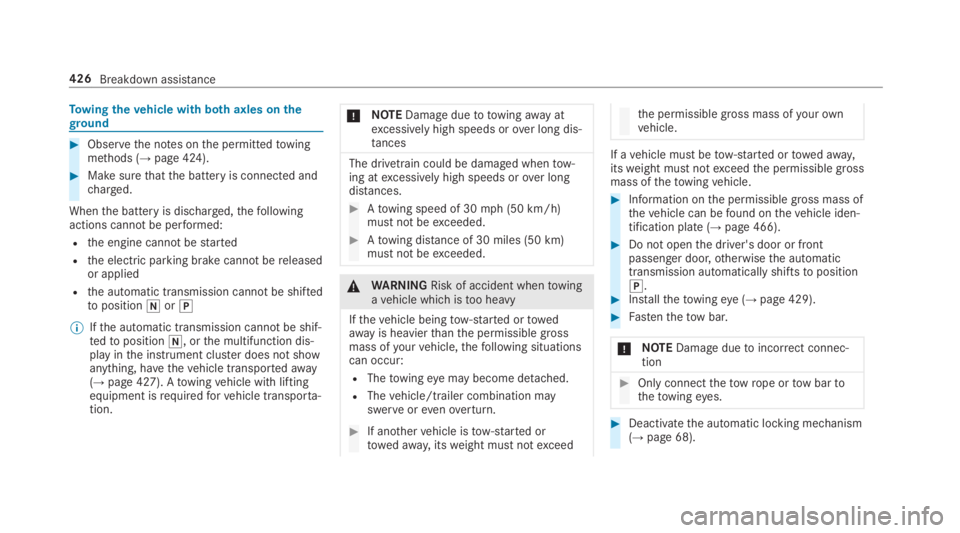
Towingthevehicle with bothaxles ontheground
#Observethe notes onthe permittedtowingmethods (→page 424).
#Make surethatthe battery is connected andcharged.
Whenthe battery is discharged,thefollowingactions cannot be performed:
Rthe engine cannotbestarted
Rthe electric parking brake cannotbereleasedor applied
Rthe automatic transmission cannotbe shiftedtoposition�\\or�]
%Ifthe automatic transmission cannotbe shif‐tedtoposition�\\, orthe multifunction dis‐play inthe instrument cluster does not showanything, havethevehicle transportedaway(→page 427). Atowingvehicle with liftingequipment isrequiredforvehicle transporta‐tion.
*NOTEDamagedueto towingawayatexcessively high speeds orover long dis‐tances
The drivetrain could be damaged whentow‐ing atexcessively high speeds orover longdistances.
#Atowing speed of 30mph (50 km/h)must not beexceeded.
#Atowing distance of 30 miles (50 km)mustnot beexceeded.
&WARNINGRisk of accident whentowingavehicle which istoo heavy
Ifthevehicle beingtow-started ortowedawayis heavierthanthe permissible grossmass ofyourvehicle,thefollowing situationscan occur:
RThetowingeye may become detached.
RThevehicle/trailer combination mayswerveorevenoverturn.
#If anothervehicle istow-started ortowedaway, itsweight must notexceed
the permissible gross mass ofyourownvehicle.
If avehicle must betow-started ortowedaway,itsweight must notexceedthe permissible grossmass ofthetowingvehicle.
#Information onthe permissible gross mass ofthevehicle can befound onthevehicle iden‐tification plate (→page 466).
#Do not openthe driver's door or frontpassenger door,otherwisethe automatictransmission automatically shiftstoposition�].#Installthetowingeye (→page 429).
#Fastenthetow bar.
*NOTEDamageduetoincorrect connec‐tion
#Only connectthetowrope ortow bartothetowingeyes.
#Deactivatethe automatic locking mechanism(→page 68).
426Breakdown assistance
Page 429 of 578
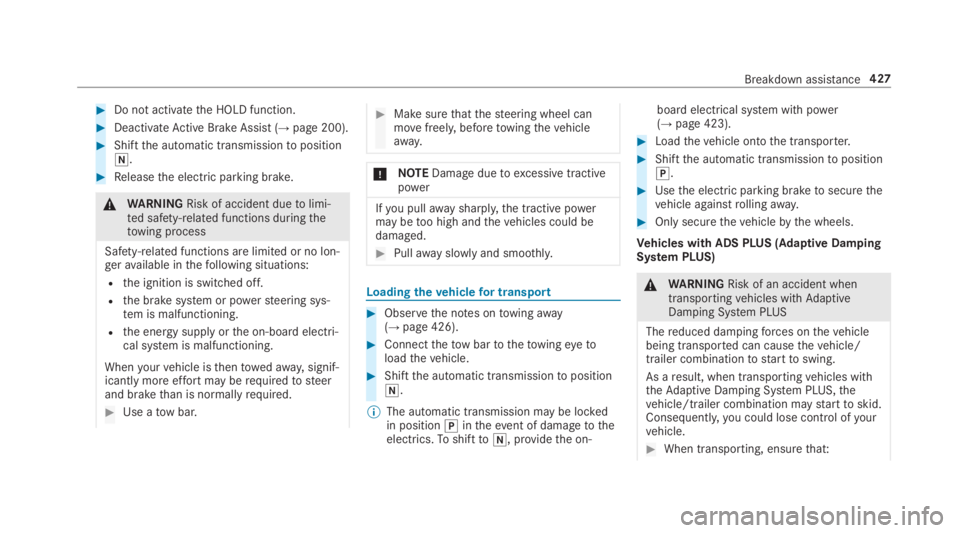
#Do not activatethe HOLD function.
#DeactivateActive Brake Assist (→page 200).
#Shiftthe automatic transmissiontoposition�\\.
#Releasethe electric parking brake.
&WARNINGRisk of accident duetolimi‐ted safety-related functions duringthetowing process
Safety-related functions are limited or no lon‐geravailable inthefollowing situations:
Rthe ignition is switched off.
Rthe brake system or powersteering sys‐tem is malfunctioning.
Rthe energy supply orthe on-board electri‐cal system is malfunctioning.
Whenyourvehicle isthentowedaway, signif‐icantly more effortmay berequiredtosteerand brakethan is normallyrequired.
#Use atow bar.
#Make surethatthesteering wheel canmovefreely, beforetowingthevehicleaway.
*NOTEDamageduetoexcessive tractivepower
Ifyou pullawaysharply,the tractive powermay betoo high andthevehicles could bedamaged.
#Pullawayslowly and smoothly.
Loading thevehiclefor transport
#Observethe notes ontowingaway(→page 426).
#Connectthetow bartothetowingeyetoloadthevehicle.
#Shiftthe automatic transmissiontoposition�\\.
%The automatic transmission may be lockedin position�]intheevent of damagetotheelectrics.Toshiftto�\\, providethe on-
board electrical system with power(→page 423).
#Loadthevehicle ontothe transporter.
#Shiftthe automatic transmissiontoposition�].
#Usethe electric parking braketosecurethevehicle againstrollingaway.
#Only securethevehiclebythe wheels.
Vehicles with ADS PLUS (Adaptive DampingSystem PLUS)
&WARNINGRisk of an accident whentransportingvehicles withAdaptiveDamping System PLUS
Thereduced dampingforces onthevehiclebeing transported can causethevehicle/trailer combinationtostarttoswing.
As aresult, when transportingvehicles withtheAdaptive Damping System PLUS,thevehicle/trailer combination maystarttoskid.Consequently,you could lose control ofyourvehicle.
#When transporting, ensurethat:
Breakdown assistance427
Page 538 of 578
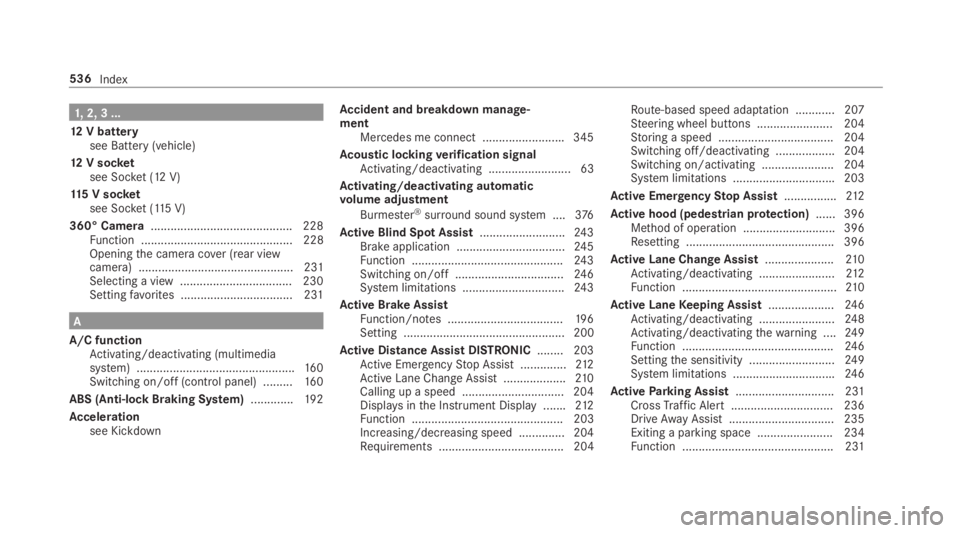
1,2, 3 ...
12V batterysee Battery (vehicle)
12V socketsee Socket (12 V)
115 V socketsee Socket (115V)
360° Camera........................................... 228Function .............................................. 228Openingthe camera cover (rear viewcamera) ............................................... 231Selecting a view .................................. 230Settingfavorites ..................................231
A
A/C functionActivating/deactivating (multimediasystem) ................................................16 0Switching on/off (control panel) .........16 0
ABS (Anti-lock Braking System).............192
Accelerationsee Kickdown
Accident and breakdown manage‐mentMercedes me connect .........................345
Acoustic lockingverification signalActivating/deactivating ......................... 63
Activating/deactivating automaticvolume adjustment
Burmester®surround sound system ....376
Active Blind Spot Assist..........................24 3Brake application .................................24 5Function ..............................................24 3Switching on/off .................................24 6System limitations ...............................243
Active Brake AssistFunction/notes ...................................19 6Setting ................................................. 200
Active Distance Assist DISTRONIC........ 203Active EmergencyStop Assist ..............212Active Lane Change Assist...................210Calling up a speed ...............................204Displays inthe Instrument Display .......212Function .............................................. 203Increasing/decreasing speed .............. 204Requirements ...................................... 204
Route-based speed adaptation ............207Steering wheel buttons ....................... 204Storing a speed ................................... 204Switching off/deactivating .................. 204Switching on/activating ......................204System limitations ...............................203
Active EmergencyStop Assist................212
Active hood (pedestrian protection)...... 396Method of operation ............................396Resetting ............................................. 396
Active Lane Change Assist.....................210Activating/deactivating .......................212Function ...............................................210
Active LaneKeeping Assist....................24 6Activating/deactivating .......................248Activating/deactivatingthewarning ....24 9Function ..............................................24 6Settingthe sensitivity ..........................24 9System limitations ...............................246
ActiveParking Assist.............................. 231CrossTraffic Alert ............................... 236DriveAwayAssist................................ 235Exiting a parking space .......................234Function .............................................. 231
536Index
Page 539 of 578

Maneuvering assistance ...................... 237Parking ................................................ 233System limitations ...............................231
Active Service System PLUSsee ASSYSTPLUS
Active Speed Limit Assist....................... 206Display ................................................ 206Function .............................................. 206
ActiveSteering Assist.............................208Activating/deactivating .......................210Active EmergencyStop Assist ..............212Active Lane Change Assist...................210Displays inthe Instrument Display .......212Function .............................................. 208System limitations ...............................208
Adaptive cruise controlseeActive Distance AssistDISTRONIC
Adaptive Highbeam AssistFunction ..............................................14 8Switching on/off .................................14 9
AdditionalvaluerangeSetting display content ........................ 254
Additives..................................................470Engine oil .............................................470Fuel .....................................................470
Additives (engine oil)seeAdditives
Additives (fuel)seeFuel
Address booksee Contacts
Adjusting the balance/fader
Burmester®high-end 3D surroundsound system ......................................377
Burmester®surround sound system ....376
Adjusting the bass, mid-range andtreble
Burmester®high-end 3D surroundsound system ......................................376
Adjusting the mid-range, treble andbass
Burmester®high-end 3D surroundsound system ......................................376
Adjusting the soundfocus
Burmester®surround sound system ....376
Adjusting the sound optimization
Burmester®high-end 3D surroundsound system ......................................377
Adjusting treble, mid-range and basssettings
Burmester®high-end 3D surroundsound system ......................................376
Burmester®surround sound system ....376
ADS PLUS damping systemsee AIRMATIC
After-sales service centersee ASSYST PLUS
Air bagReduced protection ...............................40
Air distributionSetting (multimedia system) ................161
Air freshener systemseePerfume atomizer
Air inletsee Air-water duct
Air pressureseeTirepressure
Index537
Page 541 of 578
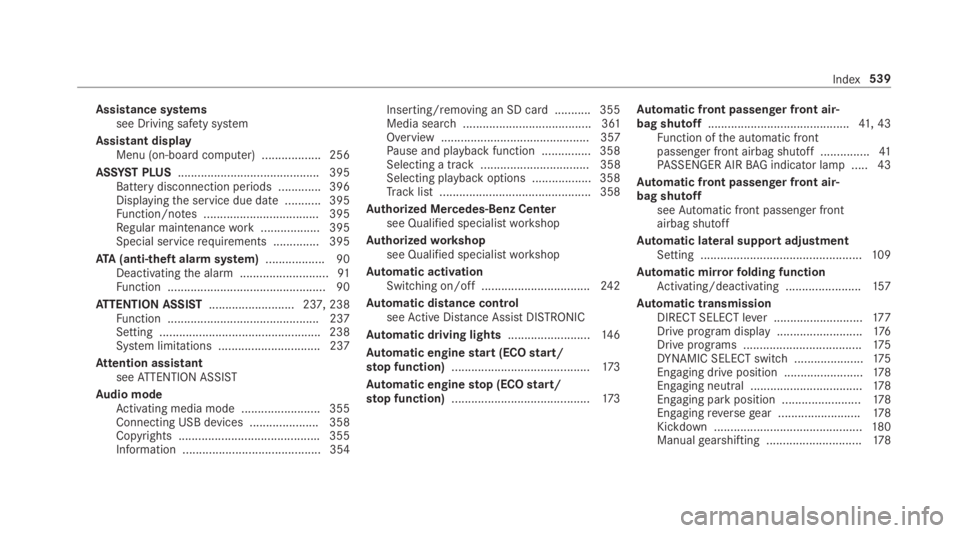
Assistance systemssee Driving safety system
Assistant displayMenu (on-board computer) .................. 256
ASSYST PLUS........................................... 395Battery disconnection periods .............396Displayingthe service due date ........... 395Function/notes ................................... 395Regular maintenancework.................. 395Special servicerequirements .............. 395
ATA(anti-theft alarmsystem).................. 90Deactivatingthe alarm ...........................91Function ................................................ 90
ATTENTION ASSIST.......................... 237, 238Function .............................................. 237Setting ................................................. 238System limitations ...............................237
Attention assistantseeATTENTION ASSIST
Audio modeActivating media mode ........................ 355Connecting USB devices ..................... 358Copyrights ...........................................355Information .......................................... 354
Inserting/removing an SD card ........... 355Media search ....................................... 361Overview ............................................. 357Pause and playback function ...............358Selecting a track ................................. 358Selecting playbackoptions .................. 358Track list .............................................. 358
Authorized Mercedes-Benz Centersee Qualified specialistworkshop
Authorizedworkshopsee Qualified specialistworkshop
Automatic activationSwitching on/off.................................24 2
Automatic distance controlseeActive Distance AssistDISTRONIC
Automatic driving lights.........................14 6
Automatic enginestart (ECOstart/stop function)..........................................173
Automatic enginestop (ECOstart/stop function)..........................................173
Automatic front passenger front air‐bag shutoff...........................................41, 43Function ofthe automatic frontpassenger front airbag shutoff ...............41PASSENGER AIRBAG indicator lamp .....43
Automatic front passenger front air‐bag shutoffseeAutomatic front passenger frontairbag shutoff
Automatic lateral support adjustmentSetting .................................................109
Automatic mirrorfolding functionActivating/deactivating .......................157
Automatic transmissionDIRECT SELECT lever ...........................17 7Drive program display ..........................176Drive programs ....................................175DYNAMIC SELECT switch .....................175Engaging drive position ........................178Engaging neutral ..................................178Engaging parkposition ........................178Engagingreversegear .........................178Kickdown .............................................180Manualgearshifting .............................178
Index539